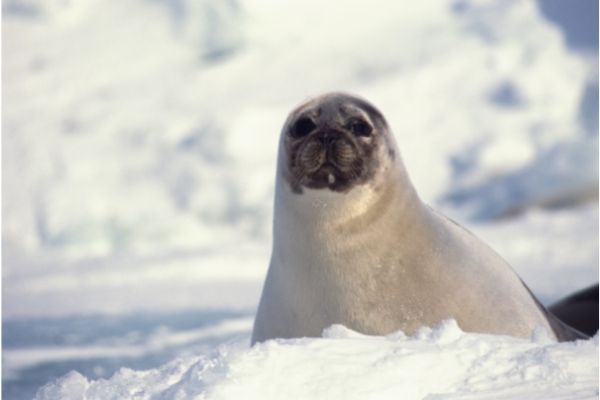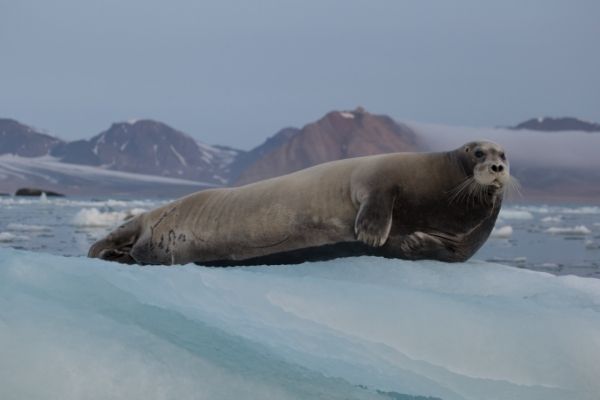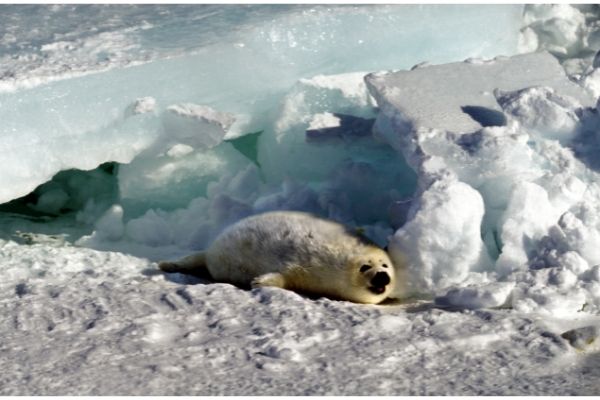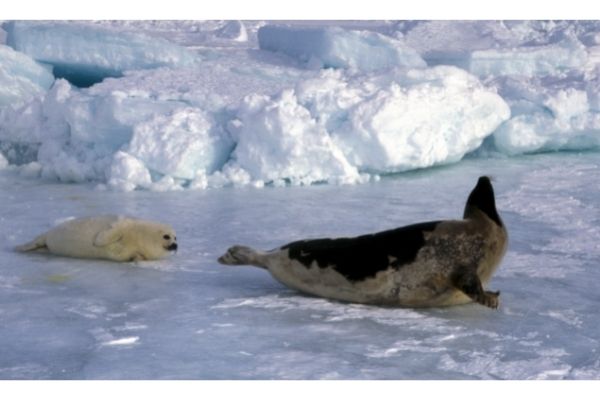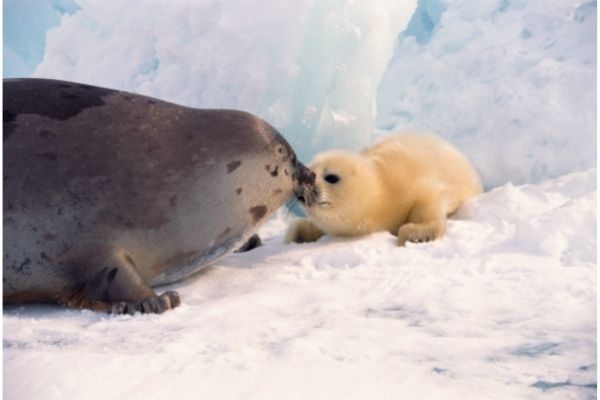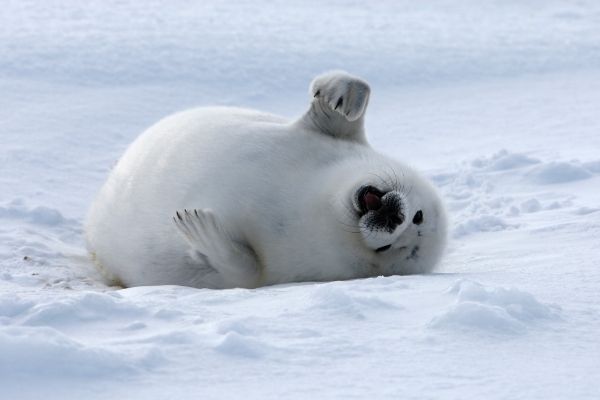The harp seal is an earless seal that is found in the Arctic Ocean and the northernmost Atlantic Ocean. It spends most of its time swimming and diving in the icy water. We have listed down complete Harp Seals Facts For Kids that will help you in learning all about Harp Seals. You are going to learn about its scientific name & classification, evolution, appearance, physical features, physical abilities, diet, habitat, lifespan, reproduction, babies, behavior, adaptations, food chain, ecological role, endangerment, population, predators, and many other interesting facts about Harp Seals.
Harp Seals Facts For Kids
What Is A Harp Seal
- A harp seal is a true seal (earless seal) species.
- It is also known as Greenland seal or saddleback seal.
- Harp seal is indigenous to the Arctic ocean and the north-most Atlantic ocean.
- There are two subspecies of harp seal;
- Pagophilus groenlandicus groenlandicus, which is distributed from eastern Canada to Norway.
- Pagophilus groenlandicus oceanicus has distributed in the White and Barents Seas.
- Harp seals are carnivores and eat fish and marine invertebrates.
- Their current conservation status on the IUCN Red List is Least Concerned.
Scientific Name
- The scientific name of the harp seal is Pagophilus groenlandicus.
Scientific Classification
The following is the scientific classification or taxonomy of harp seal:
| Kingdom | Animalia |
| Phylum | Chordata |
| Subphylum | Vertebrata |
| Class | Mammalia |
| Order | Carnivora |
| Clade | Pinnipedifformes |
| Clade | Pinnipedia |
| Family | Phocidae |
| Genus | Pagophilus |
| Species | Pagophilus groenlandicus |
Evolution Of Harp Seal
- Genetic evidence suggests that all the Pinnipeds share a common ancestor and belong to a common monophyletic group.
- A Phocid discovered in the South Atlantic is believed to be as old as 29 million years.
- Its discovery suggested that the common ancestor of the Phocids migrated to the North Atlantic through the Central American Seaway or the Arctic Basin.
- The earliest recorded fossil of harp seal has been excavated from Ocean Point, Alaska, and is about 2 million years old.
What Does A Harp Seal Look Like
Appearance
- In appearance, the harp seal looks like other true seals.
- It has a robust body and moves on the land like a caterpillar.
- A harp has a small, wide, and flattened head with a tapered snout.
- Harp Seals possess short flippers. The front flippers are equipped with strong and thick claws, while the back flippers have narrow and small claws.
- Harp seals have eight and nine pairs of teeth at the lower and upper jaws, respectively. Their dental formula is Incisors (3/2), Canines (1/1), post canines (5/5).
Color
- Adult harp seals have silver-grey color fur with wishbone or harp-shaped markings of black color that run up the dorsal sides of their flanks.
- Adult individuals have blackheads and may also have black marking at the region where their hind flippers meet their body.
Physical Features
Weight
- Adult harp seals have bodyweight from 115 to 140 kg (254 to 309 lb).
- Harp seal is a sexually dimorphic species and both the male and female individuals do not have the same body size and weight.
- Male individuals have an average body weight of 135 kg (298 lbs).
- While females have an average body weight of 120 kg (260 lbs).
Length
- Adult harp seals have body lengths from 5 feet 7 inches to 6 feet 7 inches (1.7 to 2.0 meters).
- As the harp seal is a sexually dimorphic species, male individuals are slightly larger than females.
- Male individuals grow to a length of up to 6.2 feet (1.9 meters).
- While females grow to a length of up to 5.9 feet (1.8 meters).
Fur
- Newborn harp seals have long, dense, and white fur, which absorbs much sunlight and helps them to stay warm.
- The fur of adult individuals is short with silver-grey color.
Physical Abilities
Speed
- The streamlined body shape of harp seals reduces drag force and allows them to move fast in the water.
Senses
Vision
- Harp seals have large eyes relative to their body size. A large spherical lens in their eyes improves their focusing ability.
- Their pupils are moveable that are well adapted to the intense glare of Arctic ice. They have rod-dominated retina.
- A reflective tapetum lucidum supports their retina like that of cats and intensifies their sensitivity in low light.
- Cone cells in their eyes are most sensitive to blue-green light spectra, while their rod cells help in the sensation of light intensity and may also play a role in color discrimination.
- Lacrimal glands lubricate their eyes and protect them from damage in the seawater.
Smell
- On the ice, they have a good sense of smell.
- Through smell, the mothers recognize their offspring.
- They may also detect the approaching predators through smell.
Touch
- Harp seals have whiskers, known as vibrissae.
- It exists on either side of their snout in horizontal rows.
- Whiskers provide them with a sense of touch.
- When they are underwater, their whiskers also respond to vibrations of low frequencies.
Communication
- Harp seals produce sounds to communicate.
- A pup “yells” to call its mother. When playing with each other, they “mumble”.
- Adult individuals “warble” and “growl” to warn off predators and rival harp seals.
- During the courtship and mating, adult individuals have been recorded to produce more than 19 types of sounds underwater.
What Do Harp Seals Eat
Diet
In The Wild
- Harp seals are carnivorous and mainly eat fish and aquatic invertebrates.
- Their diet largely depends on the abundance of prey, however, they are known to prefer some prey species over others.
- They consume up to 70 species of marine invertebrates and up to 67 species of fish.
- They commonly consume herring, flatfish, Gadiform fish, Capelin fish, Polar or Arctic cod, Greenland halibut, American plaice, krills, Amphipods, and other small crustaceans
- Their diet usually varies with their location and the season.
- Harp seals usually forage in coastal waters but also sometimes in mid-waters.
List Of Food Items
The following are some of the common food items:
- Herring
- Flatfish
- Gadiform fish
- Capelin fish
- Polar or Arctic cod
- Greenland halibut
- American plaice
- Krills, Amphipods, and other small crustaceans
How Much Harp Seals Eat Per Day
- A harp seal consumes about 2 to 6 kg of food per day.
- The amount of food they consume per day depends on the time of the year.
- For example, the females eat much during the pregnancy; as much as 9 kg of food per day.
- While both males and females do not eat much during molting.
What Do Baby Harp Seal Eat
- A baby harp seal initially eats mother milk.
- As it becomes slightly matured, the mother weaned him and he starts eating a carnivorous diet mostly composed of krills, Amphipods, and other small crustaceans.
Where Do Harp Seals Live – Habitat Of Harp Seal
Natural Habitat
- The natural habitat of harp seals is the coastal ocean waters near pack ice.
- They spend most of their life in water. However, they must come on the land to breed and molt.
- On the land, they prefer to spend their time on rough ice of at least 0.25-meter thickness.
- They forage at the depth of 150 to 200 meters.
- When migrating, they endure the open ocean waters.
Biome
- Harp seals are found in the icecap and coastal biomes.
Range
- The habitat range of harp seals is located in the Arctic and northern Atlantic Oceans.
- As they depend on the pack ice for breeding, their range is confined to regions where pack ice forms seasonally.
- Their range extends in the east from Hudson Bay and Baffin Island to Cape Chelyuskin, the northernmost point of mainland Russia.
- There are three major populations of harp seals;
- The first and largest population is the western North Atlantic population, which is found off eastern Canada. Based on breeding location, this population is further sub-divided into two subpopulations or herds;
- The Gulf herd, which breeds in the middle of the Gulf of St. Lawrence near the Magdalen Islands. And
- The Front herd, whose breeding ground is off the coast of Newfoundland and Labrador.
- The second population is located off the eastern Greenland, where it breeds on the “West Ice”.
- The third population is located below the Barent Sea, off the north coast of Russia, where its breeding site is the “East Ice” in the White Sea.
Countries List
The habitat range of harp seals is found in the following countries:
- Canada
- Greenland
- Ice land
- Norway
- Russia
- Svalbard Jan Mayen
- United States
Harp Seal’s Lifespan
In Wild
- The average lifespan of harp seals in the wild is 20 years.
- However, it can be as many as 30 years.
In Captivity
- It is unknown how long a harp seal lives in captivity.
Harp Seal Life Cycle
- The life cycle of a harp seal starts when it is born after a gestation period of about 11.5 months.
- Both males and females attain sexual maturity at the age of 5 to 6 years.
- They then start breeding and producing their pups.
- A Harp seal lives for a maximum age of 30 years in the wild.
Harp Seal Reproduction
- Harp seals reproduce on the ice and are considered to have promiscuous mating (randomly mate with more than one partner).
- They breed between the mid of February and April. The mating occurs underwater.
- The gestation period is about 11.5 months. In this period, the duration of fetal development is up to 8 months.
- The females delay the implantation of fertilized eggs within her womb for up to three months to delay birth until enough pack ice is available where she can reproduce.
- Harp seals usually have a single pup and twins are very rare.
- The mother nurses her pup for up to 12 days. She takes care and feeds only her pup.
- The milk of harp seals initially has 25% fat content, which increases to 40% at the time near weaning. Such a high-fat content allows the pup to grow fast and quickly thickens its blubber.
Harp Seal Pup Facts
- A baby harp seal is known as a pup.
- At birth, a pup weighs around 11 kg (24 lbs) and has a size from 31 to 33 inches (80 to 85 cm).
- The newborn pup has white and dense fur.
- A pup takes nourishment from his mother and gains about 2.2 kg (4.9 lbs) weight per day during nursing.
- The blubber in newborn pups is not developed, so they depend on the sun heating and behavioral responses (such as shivering and taking warmth in shelters and water) to manage the harsh variation in the environmental temperature after birth.
- Consumption of mother milk with high-fat content quickly thickens the blubber layer of the pups.
- During nursing, the grey coat (found in juveniles) starts to grow beneath the white coat and the weight of the pup increases to about 36 kg (79 lbs).
- About 12 days after birth, the mother weaned the pup and left him behind on the ice.
- After weaning, the pup does not walk and stays in the same locality to conserve body heat.
- Within a few days, the white coat of the pup sheds and it reaches the beater stage.
- At the age of 4 weeks, the pup starts feeding but still depends on the internal sources of energy.
- During this time, the ice starts melting and the pups become vulnerable to predators, especially polar bears. Excessive fasting also reduces their weight up to 50%.
- As many as 30% of the pups do not survive until their first birthday and die.
- At the age of 13 to 14 months, the pups again undergo molting. At this stage, they are known as bedlamers.
- Juveniles undergo molting several times, which produces a spotted harp in them.
- Both male and female pups reach sexual maturity at the age of 5 to 6 years.
Harp Seal Male Vs Female
- Harp seals are sexually dimorphic and the male individuals are slightly larger than females.
- Male individuals are also more decorated than females.
Harp Seal Behavior Facts
- Harp seals are solitary and spend most of their time alone. However, they are highly social during the breeding and molting season and form large groups of several thousand individuals. Smaller groups are also formed within large colonies, which have their hierarchies.
- Harp seals spend most of their lifetime at sea and relatively a little time on land.
- They use many types of sounds to communicate.
- Harp seals are migratory and may travel up to 5000 km distance in a year. Their migratory patterns depend on the sites where they breed and molt. Their breeding site is the southern edge of their habitat range where they breed in winter. They then molt nearby in the spring season. After molting, they then travel to the northern end of their habitat range where they spend their summer and feed. In September, they then start their journey back to the breeding sites.
Harp Seal Adaptations
Physical Or Structural Adaptations
Streamlined Body Shape
- Harp seals have a streamlined body shape, which is well-adapted to their marine habitat.
- Such body shapes reduce drag force during swimming and allow them to swim fast.
Thick Coat Of Fur
- Harp seals have a thick coat of fur that keeps their body warm along with blubber.
- Their fur is well-adapted to their lifestyle.
- In pups, the fur is extra-dense with an outer water-repellent layer and an inner insulating layer.
- They shed their fur once a year, which is replaced with a new one; the process known as molting.
Flippers
- The limbs of harp seals are adapted to flippers, which they use as oars to propel water during swimming.
Physiological Adaptations
Blubber
- Like most other marine mammals, harp seals also have a thick layer of fats beneath their skin, which is known as blubber.
- Blubber provides them insulation and also acts as an energy reservoir and provides energy during fasting or food scarcity.
- Blubber also streamlines their body and makes them efficient swimmers.
Brown Fats
- Brown fat or brown adipose tissue is a type of fat found in mammals including humans.
- In harp seals, it warms up the blood that returns from the body surface.
- Brown fat also acts as a food reservoir (especially in newly weaned pups) and provides energy.
Thermoregulation
- To manage body temperature, harp seals do not increase their metabolic rate but rather do it through the combination of anatomical and behavioral approaches.
- Their lower critical body temperature in the air is considered to be under 10° C.
- They use their flippers as heat exchangers and warm or cool their bodies as needed.
- To reduce heat loss on ice, they press their hind flippers together and their fore flippers to their body.
- Their bodies also can redirect blood flow from the periphery to reduce heat loss.
Eyes
- Harp seals have well-adapted eyes to see both below and above the water surface.
- Their eyes are also large which they use to navigate in water.
- Their pupils are also mobile to manage the intense glare of Arctic ice.
- A protective membrane is also present on their eyes like that of camels, which cover their eyes. When they are underwater, the membrane protects their eyes from the salty marine water.
Lungs
- The lungs of the harp are well-adapted to a semi-aquatic lifestyle.
- Smooth muscles as well as cartilage support airways in their lungs.
- They also have a pulmonary surfactant system in their lungs, which enables their lungs to inflate even after collapse.
Harp Seal Food Chain
- Like many other food chains, the sun is the overall source of energy in the food chain of harp seals.
- Producers are the organisms (plants and vegetations) that take energy from the sun and prepare their food for themselves.
- Primary consumers are the organisms who consume producers, such as small invertebrates.
- Secondary consumers are the predators of primary consumers, such as fish and crustaceans.
- Harp seals are tertiary consumers and eat fish, squids, and crustaceans.
- Predators are the animals who prey on the harps seals and include orca (killer whale), sharks, and polar bears.
Learn more on: What do Polar Bears Eat?
Ecological Role Of Harp Seal
- Harp seal is an important part of the marine ecosystem.
- It consumes many species of fish and marine invertebrates and helps to maintain the food web.
- Due to its movements, a harp seal also causes the transformation of nutrients from the sea to the shore. In such a way, it helps in the cycling of nutrients through the water column.
Harp Seal Population
- The recent estimated population of harp seals is 7.6 million individuals.
Harp Seal Endangerment
- The Harp seal is not an Endangered species.
Reasons
The following are some of the major reasons that may cause a threat to their survival.
Hunting
- Harp seals are commercially hunted in Canada, Norway, Russia, and Greenland for their meat and oil.
- In Canada, the Department of Fisheries and Oceans set an allowable number of catches each year for commercial, aboriginal, and personal hunting.
Entanglement
- Harp seals are often entangled in fishing gears and marine debris.
- The entangled harp seal either drowned if it can not reach the surface for breath or dragged with the gear to which it attached for long distances. It causes fatigue, severe injuries, and compromised ability of feeding and leads to declined reproductive success or even death.
Vessel Strikes
- Accidental vessel strikes severely injure or kill harp seals.
- In some coastal regions with heavy ship traffic in their habitat range, they are at high risk.
Oil Spill And Energy Exploration
- Offshore exploration of gas and oil potentially affects harp seals.
- Accidental discharge of oil or other toxic substances causes a significant threat to the harp seal.
- Oil exposure makes the fur of harp seals no longer water repellent, and it becomes difficult for them to swim, float, and stay warm.
- Swallowing or inhaling oil can destroy their digestive, respiratory, reproductive, and central nervous systems.
- Oil can also irritate or burning to their skin.
Chemical Contaminants
- Chemical contaminants entering the ocean from wastewater discharges, industrial processes, urban runoff, and oil and gas development move up the food chain and accumulate in the animals.
- Harp seals accumulate contaminants due to their blubber stores, which is a threat to their reproductive and immune system.
Climate Change
- Climate change is a threat to the survival of harp seals because they depend on the availability of pack ice to breed and molt.
- Changes in the environment affect the extent and timing of the formation and break off of the sea ice and so threaten the flourishing of harp seals.
Conservation Status
- The conservation status of harp seals is Least Concerned on the IUCN Red List.
Harp Seal Predators
- The major predators of harp seals include polar bears, Greenland sharks, orcas or killer whales, and walruses.
- Humans also prey on them for their fur, meat, and oil.
Harp Seal Fun Facts
- Harp seal is a species of true seals indigenous to the North Atlantic and the Arctic oceans.
- The name “Harp Seal” is given to them because of the harp or wishbone-shaped markings on their dorsal sides.
- The harp-shaped markings on the dorsal sides of adults as well as their black head and silver-grey fur help the harp seal to stand out from the other members of the Phocidae family found in their habitat.
- Harp seals are migratory and travel several thousand kilometers each year to reach the breeding sites in the winter and then travel back to the feeding grounds in summer. They breed in Newfoundland, the Greenland Sea, and the White Sea.
- Harp seals are solitary animals. However, they are highly social during their breeding and molting season and accumulate in large groups.
- A newborn harp seal pup has a white coat. Subsequent growth of the grey hairs beneath the white turns their coat to grey.
- The milk of harp seals has a high-fat content, which is necessary for the fast thickening of the blubber layer of the pups.
- A nursing female spends about 20% of her time on the fast-ice near her pup and about 80% time in the water to conserve energy.
- A harp seal mother feeds her pup only for about 12 days and then abandons him unattended on the ice.
- Harp seals are commercially hunted for their meat, oil, and skin that greatly affected their population size.
FAQs:
Are Harp Seals Dangerous?
- Harp seals can be extremely dangerous to humans.
- They are large wild animals that will bite and may transmit serious infections.
What Kind Of Animal Is A Harp Seal?
- Harp seal is a species of true seals or earless seals.
- It is a semi-aquatic, fin-footed, carnivorous marine mammal found in the North Atlantic and the Arctic oceans.
Can Harp Seals Be Pets?
- Harp seals look cute and cuddly but they can not be kept as pets.
- They need a special environment to survive, molt and breed.
- They are large wild animals that can be dangerous to keep as a pet.


